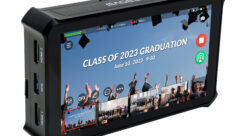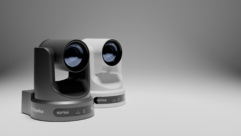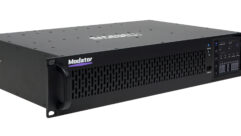
TOA HX-5B/FB-120B
Dec 1, 2005 12:00 PM,
By John McJunkin
Small speaker duo combines high quality and big sound.
TOA Electronics continues to deliver quality products of all stripes. Even if the company isn’t on your short list of speaker manufacturers in terms of name recognition, you’ll want to be aware of its new HX-5/FB-120 combination. This high-quality package consists of a subwoofer, the FB-120 ($692), and a full-bandwidth modular speaker package, the HX-5 ($494), in which four trapezoidal enclosures are combined into a single unit. Together, these two present a truly handsome package from an aesthetic standpoint, but they deliver the goods from an aural perspective as well. I got to take the rig for a spin, and I was more than pleased. Let’s dig into what I found.
Let’s look at the HX-5 first, since it represents the truly innovative half of the package. I pulled the thing out of the box, and the first thing that came to mind was “line array.” In the strictest sense of the word, it is indeed a simple line array, to the extent that it employs four identical enclosures arrayed in a vertical pattern with the goal of controlled directivity. It’s not as sophisticated as a large-scale touring system, yet it nicely accomplishes the goal. TOA refers to it as a variable dispersion speaker, and that is the perfect description. And, frankly, if a full-tilt line array is what you need, TOA makes them as well.
Since the four enclosures are intended for use only as an integrated unit (and due to wiring, can literally be used only that way), there’s really no point in describing the individual cabinets, other than to say that they are trapezoidal and made of polypropylene. Each enclosure features a center-positioned 5in. cone-type LF driver, and three vertically arrayed, balanced-dome-type HF drivers. In the four-enclosure arrangement, the LF drivers stack one above another, and similarly, you wind up with 12 HF drivers in a vertical line. Mind you, the package as a whole can be used in either orientation, depending upon the dispersion pattern you want. I’m guessing that in most applications, they’ll be used vertically. The unit accepts input via Speakon NL4MP or M4 screw terminals. The speakers are crossed over internally and passively at 4kHz, and overload protection circuitry is employed to help avoid damage to the drivers. One other thing, these units are available in black or white, and in weather-resistant versions.
Each four-enclosure unit has a mounting plate in the rear, the orientation of which you can rotate to meet your installation needs. Suspension brackets are included to enable either vertical or horizontal suspension of the unit. Rigging frames are also available for a line-array-style setup. Additionally, an adapter is available for speaker-on-a-stick applications. The most important aspect of the HX-5’s hardware is the ability to adjust the dispersion angle. The relative angle between each of the enclosures is adjustable from 15 to 60 degrees in 15-degree increments. For most applications, the angles will all be set the same, but it is indeed possible to achieve asymmetrical dispersion angles if you care to do so. Moreover, hardware is available to combine multiple HX-5 units. For instance, two of the units can be set for a 30-degree dispersion angle, and when combined, 60 degrees of dispersion is achieved, but with greater output at lower frequencies. Due to the unit’s light weight (35lbs.) you can array as many as four HX-5s. Obviously, more units mean more energy dispersion, and the array drastically reduces comb filtering and interference effects.
The FB-120 subwoofer is just about as simple as a subwoofer gets, just an unpretentious box that would be a perfect cube if it weren’t quite so deep. It contains a 12in. LF driver, and the enclosure is wood with a black painted finish and a punched steel plate grille. Speakon NL4MP or M4 screw terminals get your signal into the box. Two ports are built unobtrusively into two corners of the cabinet. Otherwise, no folded horn arrangements — just a plain vanilla box. Once again, the HX-5 half of this combination is the sophisticated part of the package!
I have to admit that I was a little skeptical about the potential SPL that these little boxes were capable of producing. I had little doubt that the quality of the audio would be great — I just couldn’t quite wrap my mind around the possibility that these would be “ideal for auditoriums, houses of worship, and gymnasiums,” as TOA’s brochure proclaims. Then I turned them on. Wow. Not only is the quality of the audio truly excellent, but also the quantity of audio is more than impressive. The long-throw LF driver in the subwoofer box moves a huge amount of air and is very impressive, but the SPL created by the HX-5 is truly surprising, considering the size of the package. TOA does not publish a maximum SPL rating for either of these speakers, but it is very solid, more than adequate for the applications touted by the company’s brochure. To be sure, I would probably want a pair of the HX-5s and a subwoofer on either side in a large-room stereo application like a gymnasium, but that combination would certainly pack the necessary punch. For that matter, a subwoofer is not even necessary if speech and/or light music are the only program material. For a higher-energy (read: higher SPL) conference or seminar, the subs would be pretty much necessary.
As to the quality of the audio, my ear is very pleased. I make no claims that I have the technical capability to measure the spectral or polar dispersion of these speakers better than TOA (and they provide extensive and detailed graphical information about the dispersion of these speakers in virtually every possible configuration), but I used SIA Smaart and determined that the representations made by TOA are honest. The dispersion is nicely controlled by the line-array arrangement, which solves a lot of problems in highly reverberant spaces. These speakers are perfect for such applications. One other thing, and this is an important point: There was no audible distortion, even at significantly high SPLs. That was one thing that really astonished me — the absolute clarity of the signal. Very impressive. And, at low SPLs, all of the signal was there, from top to bottom. With a horizontal coverage pattern 100 degrees wide, the HX-5s can cover a broad area. A 70V transformer is available, but it’s hard to imagine many common applications where these speakers would be used in a distributed audio network.
Bottom line, TOA delivers a truly excellent package here, with high-quality audio at a more than sufficiently high SPL. These speakers are perfect for both fixed installs and mobile use, even by a DJ with no audio training. Color me impressed!
PRODUCT SUMMARY
Company: TOA Electronics
www.toaelectronics.com
Product: HX-5B/FB-120B
Pros: SPL is surprising, considering the size of the boxes.
Cons: The subwoofer is definitely necessary for most music applications.
Applications: Ideal for auditoriums, houses of worship, and gymnasiums.
Price: $494 (HX-5B); $692 (FB-120B)
SPECIFICATIONS
HX-5B Power Handling Capacity: Continuous pink noise — 200W, continuous program — 600W
Impedance: 8Ω
Sensitivity: 96dB (60-degree mode), 97dB (45-degree mode), 99dB (15-degree mode)
Frequency Response: 70Hz-85Hz low frequency to 20kHz contingent upon mode
Crossover Frequency: 4kHz
Directivity Angle: Horizontal — 100 degrees (more than 2kHz), Vertical — 60 degrees (more than 800Hz), 45 degrees (more than 1.2kHz), 30 degrees (more than 1.6kHz), 15 degrees (more than 3.2kHz)
Dimensions: 16″×21.5″×13.5″ (W×H×D)
Weight: 35lbs.
FB-120B
Power Handling Capacity: Continuous pink noise — 200W, continuous program — 600W
Impedance: 8Ω
Sensitivity: 90dB (1W/m) free sound field, 96dB (1W/m) 1/2 free sound field
Frequency Response: 40Hz-1.2kHz (+/-10dB)
Dimensions: 16″×16″×17.75″ (W×H×D)
Weight: 33lbs.
John McJunkin is the principal of Avalon Studio Service in Phoenix and consults for both studios and live sound applications.










